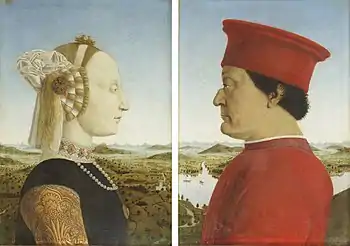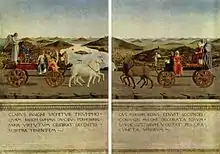The Duke and Duchess of Urbino
The double portrait of the Dukes of Urbino, also known as the Diptych of Federico da Montefeltro and Battista Sforza is a diptych, oil on wood(47 × 33 cm each panel), with portraits of the Federico da Montefeltro and Battista Sforza.[1] It is the work of Piero della Francesca dated to about 1465 to 1472 and in Room 8 of the Uffizi Gallery[2] in Florence. He created the left half of the painting as a memorial for the Duchess after her death.[3]It is one of the most famous works of the Italian Renaissance.[4]It is a tempera made over wood.[5]
| The Duke and Duchess of Urbino | |
|---|---|
| Diptych of Federico da Montefeltro and Battista Sforza | |
 | |
| Artist | Piero della Francesca |
| Year | 1465-1472 circa |
| Medium | Tempera |
| Dimensions | 47 cm × 66 cm (19 in × 26 in) |
| Location | Uffizi Gallery, Florence |
Composition
The profiles of Battista and Federico stand out among a sweeping landscape. This background helped Piero celebrate the duke and duchesses as the proud landowners and rulers of Urbino.[6] The continuous landscape also suggests the expansive extent of their rule. Piero uses atmospheric perspective, which softens all things the contours of the landscape as they recede into the distance. In the painting the Duke and Duchess appear to lack emotions, being unaffected by human desires or the turmoil in themselves or the dukedom. The space between the two rulers is symbolic of area which the Duke and Duchess ruled. The skin color of the Duchess not only respects the aesthetic conventions which were fashionable during the Renaissance.[2] Or he used that skin color as a pallor of death. He also painted her as having a high forehead because that was the height of fashion at the time.[3]Federico is painted facing the left because that way he can look at his wife, suggesting they have a bond.[3]

The back of these portraits are painted with scenes of allegories of triumphs. Horses pull Federico's triumphal car and Battista's is pulled by unicorns, which symbolize chastity and fidelity, respectively. Whereas Temperance, Fortitude, Justice and Prudence sit on Federico's car, Battista is accompanied by Chastity and Modesty, and Charity and Faith sit at the front of her car.
Beneath these scenes of triumph, Latin inscriptions celebrate the virtues of Federico and Battista. Federico's inscription extols the “fame of his virtues” and Battista's says she is “honored by the achievements of her husbands.”
Notably, Piero uses soft colors and radiant atmosphere that are evocative of the work of Rogier van der Weyden and Jan van Eyck, artists who were well known in Italy at the time. Piero likely created this sense of luminosity using oil glazes indicative of the Flemish style.[7]
Humanist influence is evident in the double portrait of Battista and Federico, including the triumphal processions evocative of the ancient Roman triumph on the obverse and the sharp, numismatic profiles indicative of the antique style.
Keeping with the tradition of fourteenth century paintings, and also inspired by the design of ancient coins, these two figures are shown in profile. This angle ensures "good likeness and a faithful representation of facial details without allowing their sentiments to show through."[2]
References
| Wikimedia Commons has media related to Double portrait of the Dukes of Urbino. |
- "N. Cat. 00281147". Centro di Documentazione. Polo Museale Fiorentino. Retrieved January 24, 2017.
- "The Duke and Duchess of Urbino Federico da Montefeltro and Battista Sforza | Artworks | Uffizi Galleries". www.uffizi.it. Retrieved 2020-05-01.
- "15 Facts About 'Portraits of the Duke and Duchess of Urbino'". www.mentalfloss.com. 2017-01-24. Retrieved 2020-05-01.
- "Portraits of the Dukes of Urbino by Piero della Francesca". Guide to Uffizi Gallery Museum. Retrieved September 23, 2018.
- Walther, Ingo F. (2005). Los maestros de la pintura occidental. Taschen. p. 99. ISBN 3-8228-4744-5.
- Baldwin, Robert (1987). "Politics, Nature, and the Dignity of Man in Piero Della Francesca's Portraits of Battista Sforza and Federico da Montefeltro". Source: Notes in the History of Art. 6 (3): 14–19. doi:10.1086/sou.6.3.23202317. ISSN 0737-4453.
- Dorra, Henri; Hartt, Frederick; Spencer, Harold; Rothschild, Lincoln (1978). "Art, a History of Painting-Sculpture-Architecture". Art Journal. 37 (4): 353. doi:10.2307/776052. ISSN 0004-3249. JSTOR 776052.